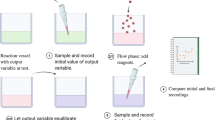Abstract
Cell metabolism is an extremely complicated dynamical system that maintains important cellular functions despite large changes in inputs. This “homeostasis” does not mean that the dynamical system is rigid and fixed. Typically, large changes in external variables cause large changes in some internal variables so that, through various regulatory mechanisms, certain other internal variables (concentrations or velocities) remain approximately constant over a finite range of inputs. Outside that range, the mechanisms cease to function and concentrations change rapidly with changes in inputs. In this paper we analyze four different common biochemical homeostatic mechanisms: feedforward excitation, feedback inhibition, kinetic homeostasis, and parallel inhibition. We show that all four mechanisms can occur in a single biological network, using folate and methionine metabolism as an example. Golubitsky and Stewart have proposed a method to find homeostatic nodes in networks. We show that their method works for two of these mechanisms but not the other two. We discuss the many interesting mathematical and biological questions that emerge from this analysis, and we explain why understanding homeostatic control is crucial for precision medicine.














Similar content being viewed by others
Notes
Golubitsky and Stewart, in preparation.
References
Alon Y (2007) An introduction to systems biology: design principles of biological circuits. Chapman and Hall, Boca Raton
Becker A, Schloder P, Steele J, Wegener G (1996) The regulation of trehalose metabolism in insects. Experientia 52:433–439
Benoit-Marand M, Borelli E, Gonon F (2001) Inhibition of dopamine release via presynaptic D2 receptors. Neuroscience 21(9):34–41
Best J, Nijhout MRHF (2009) Homeostatic mechanisms in dopamine synthesis and release: a mathematical model. Theor Biol Med Model 6(1):21
Best J, Nijhout MRHF (2010) Serotonin synthesis, release, and reuptake in terminals: a mathematical model. Theor Biol Med Model 7(1):34
Cannon WB (1926) A Charles Richet : ses amis, ses collègues, ses élèves, Paris: Les Éditions Médicales 1926 chap. Physiological regulation of normal states: some tentative postulates concerning biological homeostatics
Chaplin M, Burke C (1990) Enzyme technology. Cambridge University Press, Cambridge
Clarke S, Banfield K (2001) S-adenosyl-methionine dependent methyltransferases. Homocysteine in health and disease. Cambridge University Press, Cambridge, pp 63–78
Cornish-Bowden A (2012) Fundamentals of enzyme kinetics. Portland Press, Portland
Drengstig T, Jolma I, Ni X, Thorsen K, Xu X, Ruoff P (2012) A basic set of homeostatic controller motifs. Biophys J 103:2000–2010
Elliott D, Newman K, Forward D, Hahn D, Ollivere B, Kojima K, Handley R, Rossiter N, Wixted J, Smith R, Moran C (2016) A unified theory of bone healing. Bone and Joint J 98–B:884–91
Golubitsky M, Stewart I (2017) Homeostasis, singularities and networks. J Math Biol 74(1–2):387–407. doi:10.1007/s00285-016-1024-2
Golubitsky M, Stewart I, Best J, Reed M, Nijhout F (2017) Homeostasis with multiple inputs. Preprint
Green N, Lee L (2012) Modern and evolving understanding of cerebral perfusion and autoregulation. Adv Anesth 30:97–129
Haldane J (1930) Enzymes. Longmans, Green, and Co, New York
Hall J (2017) Guyton and Hall textbook of medical physiology, 13th edn. Elsevier, Philadelphia
Kilberg M, Haussinger D (eds) (1992) Mammalian amino acid transport; mechanisms and control. Plenum Press, New York
Michaelis L, Menten M (1915) Die kinetic der invertinwirkung. Biochem Z 49:333–369
Nijhout HF, Reed M (2014) Homeostasis and dynamic stability of the phenotype link robustness and stability. Int Comp Biol 54:264–275
Nijhout HF, Reed M, Budu P, Ulrich C (2004) A mathematical model of the folate cycle: new insights into folate homeostasis. J Biol Chem 226:33–43
Nijhout HF, Reed M, Anderson D, Mattingly J, James SJ, Ulrich C (2006) Long-range allosteric interactions between the folate and methionine cycles stabilize the DNA methylation reaction. Epigenetics 1:81–87
Nijhout HF, Best J, Reed M (2014) Escape from homeostasis. Math Biosci 257:104–110
Nijhout HF, Best J, Reed M (2015) Using mathematical models to understand metabolism, genes and disease. BMC Biol 13(1):79
Reed M, Thomas R, Pavisic J, James SJ, Ulrich C (2008) A mathematical model of glutathione metabolism. Theor Biol Med Model 5(1):8
Reed M, Lieb A, Nijhout HF (2010) The biological significance of substrate inhibition: a mechanism with many functions. BioEssays 32:422–429
Reed M, Gamble M, Hall M, Nijhout HF (2014) Mathematical analysis of the regulation of competing methyltransferases. BMC Syst Biol 9(1):69
Segel IH (1975) Enzyme kinetics. Wiley-Interscience, New York
Segel L (1984) Modeling dynamic phenomena in molecular and cellular biology. Cambridge University Press, Cambridge
Storey K (ed) (2004) Functional metabolism: regulation and adaptation. Wiley-Liss, Hoboken
Segel L (ed) (1980) Mathematical models in molecular and cellular biology. Cambridge University Press, Cambridge
Wagner C, Briggs WT, Cook RJ (1985) Inhibition of glycine N-methyltransferase activity by folate derivatives: implications for regulation of methyl group metabolism. Biochem Biophys Res Commun 127:746–752
Acknowledgements
The authors gratefully acknowledge support from the National Science Foundation and the National Institutes of Health.
Funding This research was supported by National Institutes of Health Grants 1R01MH106563-01A1 (JAB,MCR, HFN) and 1R21MH109959-01A1(JAB,MCR, HFN) and NSF Grants IOS-1562701 (HFN), EF-1038593, IOS-1557341(HFN,MCR) and DMS-1440386 to the Mathematical Biosciences Institute (MG).
Author information
Authors and Affiliations
Contributions
All authors contributed to the ideas in the manuscript. Golubitsky and Stewart did the calculations about GS homeostasis points and GS chairs. MR and JB did the other analytical calculations. MR, JB, and HFN wrote the manuscript. All authors read, edited, and approved the manuscript.
Corresponding author
Ethics declarations
Conflicts of interest
No competing interests declared.
Rights and permissions
About this article
Cite this article
Reed, M., Best, J., Golubitsky, M. et al. Analysis of Homeostatic Mechanisms in Biochemical Networks. Bull Math Biol 79, 2534–2557 (2017). https://doi.org/10.1007/s11538-017-0340-z
Received:
Accepted:
Published:
Issue Date:
DOI: https://doi.org/10.1007/s11538-017-0340-z




